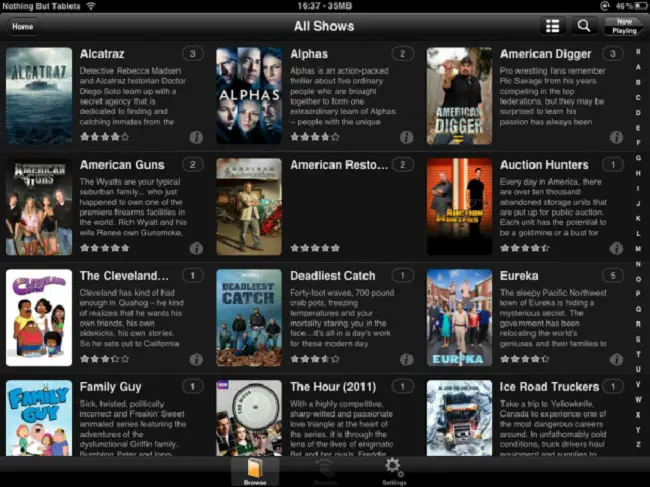Plex media system review
 I’ve previously written about how I got my Android devices to stream from a shared Windows folder, hence avoiding any on-the-go transcoding. Recently however I checked out Plex, a media system that is pretty much what I wanted to avoid back in the previous article. In this review you’ll find out why it’s installed on all my devices despite that.
I’ve previously written about how I got my Android devices to stream from a shared Windows folder, hence avoiding any on-the-go transcoding. Recently however I checked out Plex, a media system that is pretty much what I wanted to avoid back in the previous article. In this review you’ll find out why it’s installed on all my devices despite that.
How it works: Server side
Plex is hard to describe with normal terms because it’s both a media center, media server, media streaming solution, and a media organizer. It consists of a media server program for PCs (Windows, Linux, and MacOS), a media center app for Windows and MacOS, mobile apps for Android, iOS, and Windows Phone 7, and ways to be set up with internet connected devices including Google TV and Roku.
Which end level setup you end up using is up to you, but you need to have the media server running somewhere. This is the back end program that scans your media and serves it out to all the client devices. You can add music, TV shows, movies, home videos, and photos to the server. It then analyzes this media and automatically reads file names to determine what the content is. Add a folder of a TV series where files are named (e.g., big.bang.theory.1×02.dvdrip) and the end result in Plex will be a season listing where you don’t see any ugly file names, just a series sorted into seasons and episodes. It pulls information about the content from online, showing you summaries and poster-style graphics. Some versions of the client side programs even play the theme music of TV shows when you’re browsing that series.
It should be noted that this type of “scan and detect” takes longer than less complex media servers take to add media. A friend who’s counting his media in terabytes also counts his Plex “adding media” time in days. Also, there are times when it fails to extract the right/any info from the file name, so you might have to go back and change some file names to help it along. Despite that though, it’s rather awesome, and this feature is why I started using it to begin with.
Aside from scanning local media, there are also a few other ways to get content into the server. One is channels, which picks up things like your iTunes library and makes that available to you. Another is video queues, which is a system where you get a myPlex account (for free), add a bookmarklet to your browser, and then whenever you see a video you want to watch in Plex later, you click the bookmarklet. It will extract the video from the website and make it available to you in Plex.
The final and perhaps most impressive way to get content is to get access to your friends’ servers. This is also done through myPlex, and lets you share your server with others. They can then go in and access your media just like you would.
How it works: Client side
Once armed with one (or several) media servers, it’s time to go nuts with the client side apps. The computer apps for Plex are free, but the mobile apps are $5: Android, iOS, Windows Phone 7. You install the app, connect to your server, and then you can browse the library. The sorting will persist over to these apps, so you have the same ability to sort your media by seasons and such like you do on a computer.
Streaming media is an adaptive process that depends on your device and your connection. Plex transcodes video on the go in order to provide you with a video stream that works, no matter if you’re using Plex Media Center on the computer that runs the server or if you’re using it on a Windows Phone 7 phone on a 3G connection from across the country. You can override these settings if you think you know better than Plex, but take my word for it: just let it handle it. The short version of all of this is that data rates aside, you don’t have to worry about where you are or what device you’re on, Plex will make sure that you get a video stream that works.
Since it transcodes on the fly you need a relatively decent computer, which basically means a desktop computer that’s not too old or a relatively beefy laptop. You don’t need NASA’s supercomputer though, a friend of mine and I stress tested his setup yesterday, and it handled 4 individual streams all at once. That’s me on my Android phone and iPad from here, and him on two devices on the other side of the country, all demanding a video stream from the same poor little computer. My desktop computer isn’t exactly fast in comparison, but even it has no problem handling HD transcoding.
Screenshot time
The beauty of Plex, aside from the fact that everything I described above in theory works in practice, is that it looks beautiful. As such, here’s lot of screenshots of Plex on different devices. They’ll do a better job of showing off the system than I can with words.
Windows proper





Android:


iPad




Windows Phone 7 (from Windows Marketplace)


Cooperation between clients
Now that you’ve learned how it works and seen how it looks, the final feature that deserves a mention is how the system cooperates between devices. The mobile apps can actually remote control the Windows and Mac Plex Media Center programs, which means that you don’t need the keyboard. There system also saves your playback position and syncs that across devices, so that you can watch half a video on your home theater system using your phone as a remote, then get up, walk out the door, and watch the rest of the video on what was the remote control 2 minutes earlier.
Conclusion
I normally don’t like media systems that do anything but stream the file itself, but Plex is the clear exception. The way it organizes your media is just too good to pass up, as you essentially get your own personal Netflix with resume functionality and info about movies and TV shows, and it’s all automatic. There are some hiccups here and there, and the Media Center program for Windows could use a much better windowed mode, but all in all Plex is one of the real gems out there. The fact that it’s on so many devices, even Windows Phone, just adds to that.


